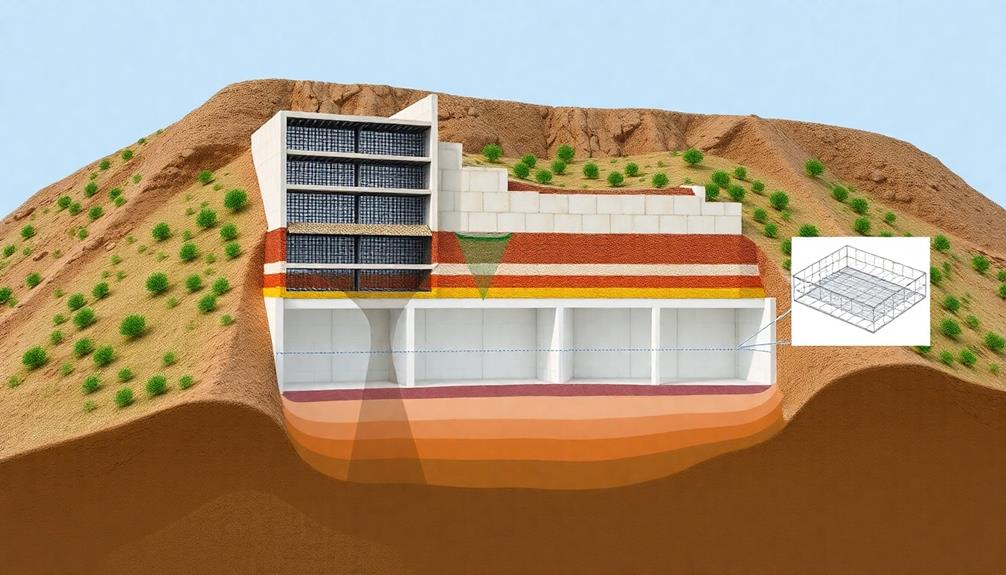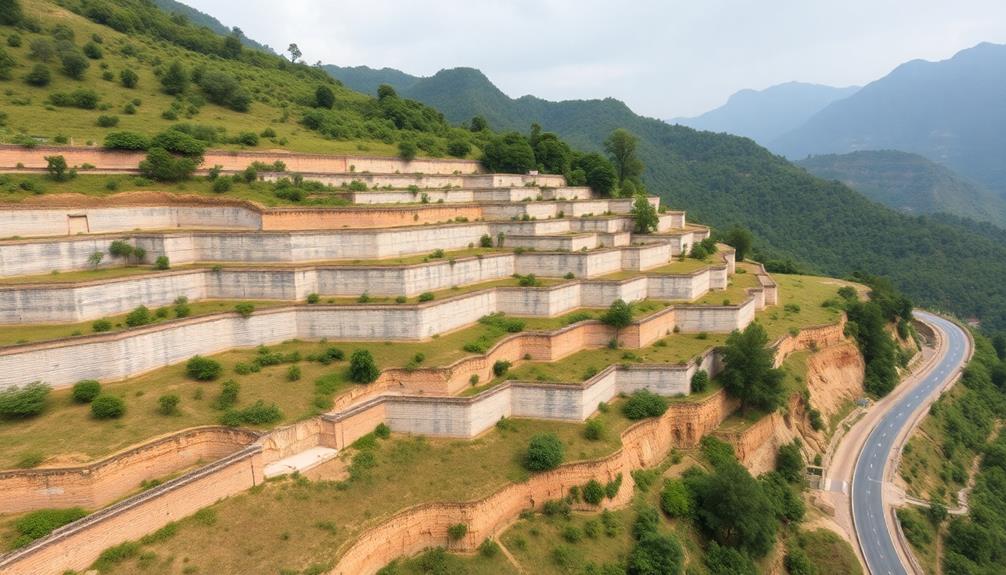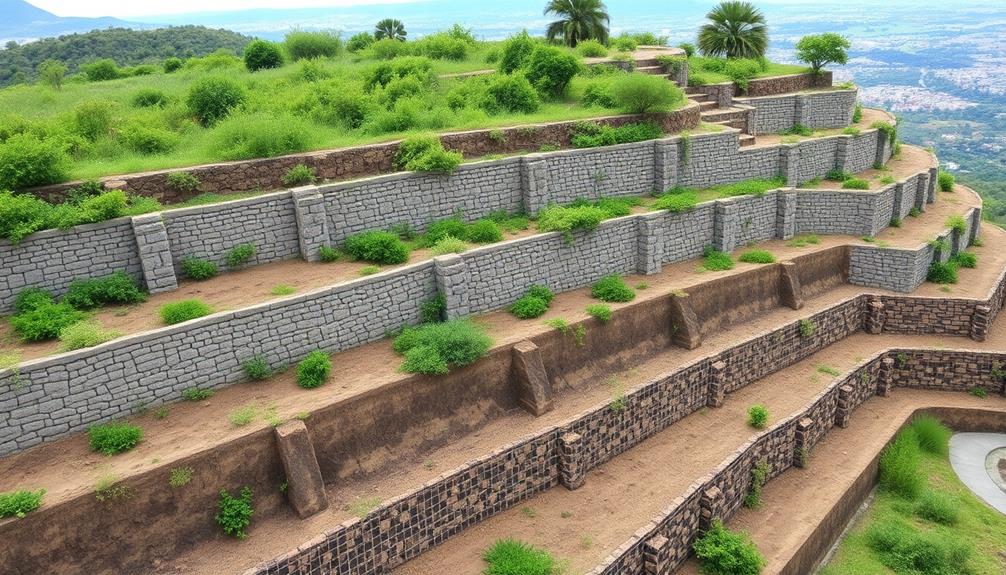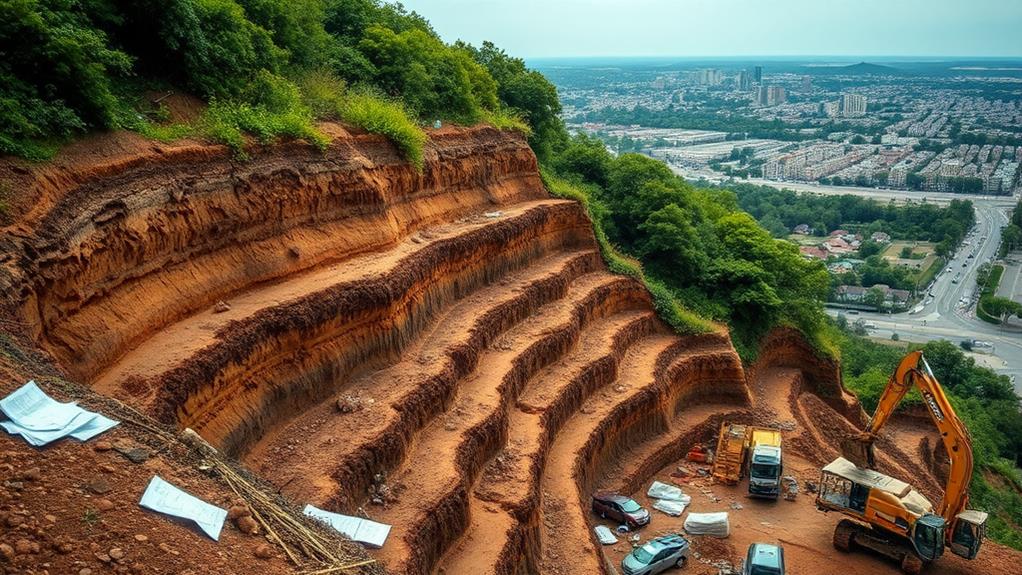Regulations are essential for retaining wall projects as they guarantee structural integrity, public safety, and environmental protection. These guidelines establish load-bearing capacity requirements, material strength standards, and reinforcement specifications, which are indispensable for withstanding lateral earth pressures and surcharge loads. By mandating thorough site investigations, proper material selection, and adherence to engineering best practices, regulations safeguard against potential failures and hazards. They also address soil erosion prevention, slope stabilization techniques, and drainage system requirements, promoting responsible development and land use practices. All-encompassing regulatory compliance not only enhances the longevity and safety of retaining walls but also standardizes construction practices, ultimately benefiting property owners and surrounding communities. Further exploration of these regulations reveals their far-reaching impact on project success.
Table of Contents
ToggleWalls Contractor Highlights
- Regulations ensure structural integrity, safeguarding against failures that could endanger lives and property.
- Standardized construction practices promote consistency in quality, performance, and safety across projects.
- Compliance with regulations prevents environmental damage by addressing erosion control and drainage requirements.
- Regulatory guidelines mandate proper material selection and reinforcement specifications for long-term stability.
- Regulations require thorough site assessments and geotechnical analyses, optimizing wall design and placement.
Structural Integrity Guidelines

Structural integrity guidelines for retaining wall projects encompass essential aspects such as load-bearing capacity requirements, material strength standards, and reinforcement specifications. These guidelines guarantee that retaining walls can withstand the substantial lateral earth pressures and surcharge loads they are designed to resist, while maintaining long-term stability and safety.
Proper engineering expertise is vital for complex retaining wall types, especially when dealing with boulder and gabion walls that require more advanced construction techniques. By adhering to these stringent structural integrity standards, engineers and contractors can create robust retaining wall systems that effectively manage soil retention, prevent erosion, and protect surrounding structures and infrastructure.
Load-Bearing Capacity Requirements
In accordance with sound engineering principles, load-bearing capacity requirements form the cornerstone of retaining wall structural integrity. These requirements guarantee that retaining walls can effectively withstand the lateral earth pressures and additional surcharges they are designed to support. By adhering to these guidelines, construction professionals and property owners contribute to the overall safety and longevity of their projects, fostering a sense of community responsibility.
Load-bearing capacity requirements typically encompass factors such as soil type, wall height, backfill material, and anticipated surcharges. Engineers must carefully calculate the maximum loads the wall will encounter throughout its lifespan, factoring in both static and dynamic forces. This all-inclusive approach allows for the development of robust designs that can withstand various environmental conditions and potential load fluctuations.
Implementing these requirements necessitates a thorough site investigation, including geotechnical analysis and soil testing. The resulting data informs the selection of appropriate materials, reinforcement methods, and drainage systems. By meticulously following load-bearing capacity requirements, stakeholders can guarantee their retaining wall projects meet or exceed industry standards, providing peace of mind and long-term structural stability for the entire community.
Material Strength Standards
Complementing the load-bearing capacity requirements, material strength standards play a pivotal role in ensuring the structural integrity of retaining walls. These standards establish minimum performance criteria for the materials used in construction, including concrete, steel reinforcement, masonry units, and geosynthetics. By adhering to these guidelines, engineers and contractors can confidently select materials that will withstand the immense pressures and environmental factors to which retaining walls are subjected.
Material strength standards encompass various aspects, such as compressive strength, tensile strength, and durability. For concrete, specifications typically include minimum compressive strength values, while steel reinforcement must meet yield strength requirements. Masonry units are evaluated for their ability to resist cracking and weathering, and geosynthetics are tested for long-term performance under sustained loads. These standards are continuously refined based on research and field observations, ensuring that retaining wall designs incorporate the latest advancements in material science and engineering.
Reinforcement Specifications
Integrity forms the backbone of reinforcement specifications for retaining wall projects, guaranteeing the structure's long-term stability and safety. These specifications encompass a detailed set of guidelines that dictate the type, quantity, and placement of reinforcing materials within the retaining wall system. Engineers and contractors must meticulously adhere to these standards to create a cohesive structure capable of withstanding diverse environmental pressures.
The reinforcement specifications typically outline requirements for steel reinforcement bars, geosynthetic materials, and soil anchors. These components work in concert to distribute loads, prevent soil movement, and enhance the wall's overall structural integrity. Precise calculations determine the spacing and diameter of reinforcing bars, while geosynthetic materials, such as geogrids or geotextiles, are strategically incorporated to improve soil stability.
Soil anchors, when necessary, provide additional support by transferring loads to stable soil or rock formations behind the wall face. By following these exacting specifications, construction professionals guarantee that retaining walls not only meet immediate safety requirements but also maintain their structural integrity over extended periods, safeguarding both property and lives in the process.
Benefits

Regulations governing retaining wall projects offer numerous benefits that extend beyond mere structural considerations. By establishing guidelines for guaranteeing structural integrity, protecting public safety, preventing environmental damage, and standardizing construction practices, these regulations serve as an essential framework for responsible development.
Boulder retaining walls, known for their durability and natural appearance, are subject to these regulations to verify proper installation and long-term stability. Through adherence to these regulations, engineers, contractors, and property owners can collectively contribute to the creation of safer, more durable, and environmentally conscious retaining wall structures that stand the test of time while minimizing potential risks to both people and the surrounding ecosystem.
Ensuring Structural Integrity
Through proper adherence to regulations for retaining wall projects, safeguarding structural integrity offers numerous benefits. These regulations serve as a safeguard against potential failures, protecting both property owners and the surrounding community. By following established guidelines, contractors and engineers can design and construct retaining walls that withstand various environmental pressures, including soil loads, hydrostatic forces, and seismic activity.
Regulations typically mandate the use of appropriate materials, proper drainage systems, and adequate reinforcement techniques. These requirements ensure that retaining walls are built to last, minimizing the risk of collapse or structural damage over time. Additionally, adherence to regulations often necessitates thorough site analysis and geotechnical assessments, which provide pivotal data for optimizing wall design and placement. This extensive approach not only enhances the wall's performance but also contributes to the overall stability of the surrounding landscape.
Furthermore, regulatory compliance often involves periodic inspections and maintenance schedules, which help identify and address potential issues before they escalate. This proactive stance on structural integrity ultimately leads to increased longevity of the retaining wall, reduced repair costs, and enhanced property value for homeowners and businesses alike.
Protecting Public Safety
Public safety stands as a paramount concern in the implementation of regulations for retaining wall projects. These regulations serve as a vital safeguard, protecting not only the property owners but also the surrounding community from potential hazards associated with improperly constructed or maintained retaining walls. By enforcing stringent safety standards, regulatory bodies ensure that these structures are designed and built to withstand various environmental stresses, including soil pressure, water accumulation, and seismic activity.
The thorough nature of these regulations encompasses multiple aspects of public safety. They mandate comprehensive site assessments, proper material selection, and adherence to engineering best practices. Additionally, they require regular inspections and maintenance protocols to identify and address potential issues before they escalate into dangerous situations.
These measures collectively mitigate the risk of catastrophic failures, which could result in property damage, personal injury, or even loss of life. Moreover, the regulations often include provisions for emergency response planning, ensuring that in the unlikely event of a failure, there are established procedures to minimize harm and facilitate swift remediation. By prioritizing public safety through these regulations, communities foster a sense of security and trust in their built environment.
Preventing Environmental Damage
Environmental protection frequently emerges as a significant benefit of well-designed regulations for retaining wall projects. These regulations often encompass measures to mitigate soil erosion, preserve natural habitats, and maintain water quality in surrounding areas. By requiring contractors to implement erosion control techniques, such as silt fences and sediment basins, regulations help prevent the degradation of nearby waterways and ecosystems.
Likewise, guidelines for proper drainage systems guarantee that retaining walls do not disrupt natural water flow patterns, safeguarding both the immediate environment and downstream communities.
Regulations also typically address the selection of construction materials, promoting the use of environmentally friendly options that minimize ecological impact. This may include specifying permeable materials to allow for natural groundwater recharge or mandating the use of native plants for landscaping around the retaining wall. Additionally, regulations often require thorough environmental impact assessments before project approval, ensuring that potential risks to local flora and fauna are identified and mitigated. By adhering to these regulations, retaining wall projects can harmoniously coexist with their surroundings, preserving the delicate balance of ecosystems while fulfilling their structural purpose.
Standardizing Construction Practices
Standardizing construction practices for retaining wall projects offers numerous benefits that extend beyond environmental protection. By implementing uniform building methods and materials across the industry, we guarantee consistency in quality and performance. This standardization fosters a sense of reliability and trust among property owners, engineers, and contractors, creating a cohesive community of professionals dedicated to excellence.
Uniform practices streamline the construction process, reducing errors and inefficiencies. They establish a common language and set of expectations, enabling smoother collaboration between different teams and stakeholders. This shared understanding minimizes miscommunications and conflicts, ultimately leading to more successful project outcomes. Additionally, standardization facilitates easier training and skill development for workers, ensuring a competent workforce capable of delivering high-quality results consistently.
Adopting standardized practices also enhances safety measures, as proven techniques and materials are utilized across projects. This approach minimizes risks associated with experimental or untested methods, safeguarding both workers and the public. Additionally, standardization simplifies the regulatory process, making it easier for authorities to enforce compliance and maintain oversight. Ultimately, these unified practices contribute to the longevity and stability of retaining wall structures, benefiting communities for generations to come.
Soil Erosion Prevention Measures

Soil erosion prevention measures are imperative components of retaining wall projects, ensuring long-term stability and environmental protection. Effective strategies include implementing vegetation and ground cover, installing comprehensive drainage systems, and employing slope stabilization techniques. The following table outlines key aspects of these measures, highlighting their importance in preserving soil integrity and maintaining retaining wall functionality:
| Measure | Purpose | Implementation | Maintenance | Benefits |
|---|---|---|---|---|
| Vegetation and Ground Cover | Soil stabilization | Planting native species | Regular pruning and watering | Reduces runoff, enhances aesthetics |
| Drainage System | Water management | Installing pipes and channels | Periodic cleaning and inspection | Prevents water accumulation, reduces pressure |
| Slope Stabilization | Erosion control | Applying geotextiles or terracing | Monitoring for signs of movement | Increases slope stability, protects structure |
| Erosion Control Blankets | Temporary protection | Laying biodegradable mats | Replacing as needed | Facilitates vegetation growth, reduces soil loss |
| Retaining Wall Design | Structural support | Engineering for site conditions | Regular structural assessments | Provides long-term erosion prevention, ensures safety |
Vegetation and Ground Cover
Effective vegetation and ground cover strategies play a vital role in preventing soil erosion around retaining walls. These techniques not only stabilize the soil but also enhance the aesthetic appeal of the structure, creating a harmonious blend with the surrounding landscape. By implementing a well-designed vegetation plan, property owners can dramatically reduce the risk of soil displacement and guarantee the longevity of their retaining wall investments.
Regulations often mandate the use of specific plant species that are native to the area and possess deep root systems. These plants, when strategically placed, form a natural barrier against erosion by binding the soil particles together. Additionally, ground cover options such as mulch, gravel, or erosion control mats provide an extra layer of protection, particularly during the establishment period of newly planted vegetation.
It is necessary to ponder factors such as soil type, climate, and drainage patterns when selecting appropriate vegetation and ground cover solutions. Proper maintenance, including regular watering and pruning, is indispensable to ensure the continued effectiveness of these erosion prevention measures. By adhering to these regulations, we collectively contribute to the stability and sustainability of our built environment.
Drainage System Implementation
Proper implementation of drainage systems stands as a cornerstone in soil erosion prevention for retaining wall projects. These systems play a vital role in managing water flow, mitigating hydrostatic pressure, and preserving the structural integrity of the wall. By efficiently channeling water away from the retaining structure, drainage systems significantly reduce the risk of soil saturation, which can lead to instability and potential failure.
Regulations governing drainage system implementation typically mandate the inclusion of specific components, such as perforated pipes, geotextile filters, and granular backfill materials. These elements work in concert to collect and redirect water, preventing its accumulation behind the wall. Additionally, regulations often stipulate the proper sizing and placement of drainage outlets, ensuring ideal water discharge without compromising surrounding landscapes or infrastructure.
Adherence to these regulations not only safeguards the immediate project area but also contributes to the overall stability of the surrounding environment. By effectively managing water flow, well-implemented drainage systems protect neighboring properties from potential runoff issues and help maintain the long-term functionality of the retaining wall. This extensive approach to drainage underscores the importance of regulatory compliance in fostering sustainable and resilient retaining wall projects.
Slope Stabilization Techniques
Implementing robust slope stabilization techniques forms an integral part of soil erosion prevention measures in retaining wall projects. These techniques are essential for maintaining the structural integrity of the wall and safeguarding the long-term stability of the surrounding landscape. Engineers and contractors must carefully assess the site conditions, soil composition, and potential environmental factors to determine the most appropriate stabilization methods.
Common slope stabilization techniques include soil nailing, which involves inserting reinforcing bars into the soil to increase its shear strength, and geotextile reinforcement, where synthetic fabrics are layered within the soil to enhance its load-bearing capacity. Additionally, terracing and benching can be employed to reduce the overall slope angle and distribute the load more evenly. Vegetation management plays a pivotal role in preventing surface erosion by utilizing deep-rooted plants that bind the soil particles together.
In some cases, mechanically stabilized earth (MSE) systems may be necessary, incorporating precast concrete panels or wire mesh facing elements in conjunction with soil reinforcement. By implementing these techniques in accordance with local regulations, project managers can effectively mitigate erosion risks and safeguard the longevity of their retaining wall structures.
Walls Contractor FAQ
How Often Should Retaining Walls Be Inspected for Compliance With Regulations?
Retaining walls should be inspected regularly, typically annually, to guarantee compliance with regulations. However, the exact frequency may vary based on local requirements, wall size, and environmental factors. It's vital to stay informed about your area's specific guidelines.
Are There Different Regulations for Residential Versus Commercial Retaining Wall Projects?
Yes, regulations typically differ for residential and commercial retaining wall projects. Commercial projects often face stricter requirements due to higher public usage and safety concerns. Familiarizing yourself with local building codes guarantees your project meets all necessary standards.
What Are the Penalties for Non-Compliance With Retaining Wall Regulations?
Penalties for non-compliance with retaining wall regulations can vary but often include fines, stop-work orders, and mandatory remediation. In severe cases, legal action may be taken. Our community values safety, so it's essential we adhere to these important guidelines.
Do Retaining Wall Regulations Vary Significantly Between Different States or Countries?
Retaining wall regulations do vary materially between states and countries. Local jurisdictions often have specific requirements based on soil conditions, climate, and seismic activity. It's essential for homeowners and contractors to research and comply with local regulations.
Can Existing Retaining Walls Be Grandfathered in if New Regulations Are Implemented?
Grandfathering existing retaining walls when new regulations are implemented is often possible, depending on local laws. Many jurisdictions allow structures built in compliance with previous standards to remain, fostering a sense of community continuity and property owner security.







